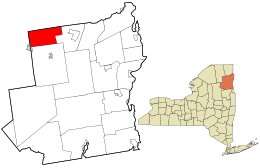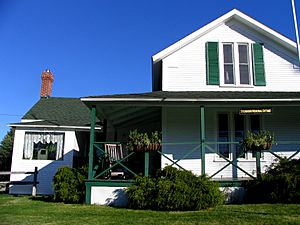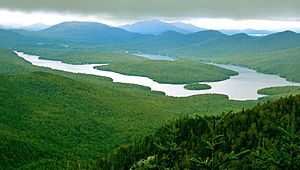St. Armand, New York facts for kids
Quick facts for kids
St. Armand, New York
|
|
|---|---|

St. Armand Town Hall in Bloomingdale, New York
|
|

Location in Essex County and the state of New York
|
|
| Country | United States |
| State | New York |
| County | Essex |
| Government | |
| • Type | Town Council |
| Area | |
| • Total | 57.45 sq mi (148.78 km2) |
| • Land | 56.51 sq mi (146.36 km2) |
| • Water | 0.93 sq mi (2.42 km2) |
| Elevation | 1,549 ft (472 m) |
| Population
(2020)
|
|
| • Total | 1,446 |
| Time zone | UTC-5 (Eastern (EST)) |
| • Summer (DST) | UTC-4 (EDT) |
| FIPS code | 36-031-64529 |
| GNIS feature ID | 0979447 |

St. Armand is a small town located in Essex County, New York, United States. In 2020, about 1,446 people lived there. An early settler named the town after Saint-Armand, Quebec, a place in Canada.
You can find the town of St. Armand in the northwestern part of Essex County. It is southwest of the city of Plattsburgh.
Contents
A Look at St. Armand's History
The first people settled in St. Armand around 1829. At first, the main business was cutting down trees for lumber. After most of the trees were gone, people started farming. The town became a busy place because five roads met there, including New York Route 3.
St. Armand became its own town in 1844. Before that, it was part of the town of Wilmington.
St. Armand's Role in Health Care
By the late 1800s, St. Armand became known for its special hospitals called sanatoria. These places helped people get better from a serious lung illness called tuberculosis (TB). In 1884, Dr. Edward Trudeau opened one of the first sanatoria near the village of Saranac Lake.
Famous People from St. Armand
- Robert Louis Stevenson, a famous author, stayed in St. Armand for a year. He was there to get better from tuberculosis.
Exploring St. Armand's Geography
According to the United States Census Bureau, St. Armand covers about 148.8 square kilometers (about 57.45 square miles). Most of this area, about 146.4 square kilometers (56.51 square miles), is land. The rest, about 2.4 square kilometers (0.93 square miles), is water.
The northern and eastern edges of the town touch the border of Franklin County. St. Armand is also located inside the beautiful Adirondack Park. The Saranac River flows through the northwestern part of the town.
New York State Route 3 is a main road that goes through the western part of St. Armand.
St. Armand's Population Over Time
| Historical population | |||
|---|---|---|---|
| Census | Pop. | %± | |
| 1850 | 210 | — | |
| 1860 | 331 | 57.6% | |
| 1870 | 335 | 1.2% | |
| 1880 | 452 | 34.9% | |
| 1890 | 633 | 40.0% | |
| 1900 | 769 | 21.5% | |
| 1910 | 746 | −3.0% | |
| 1920 | 727 | −2.5% | |
| 1930 | 1,190 | 63.7% | |
| 1940 | 1,233 | 3.6% | |
| 1950 | 1,142 | −7.4% | |
| 1960 | 868 | −24.0% | |
| 1970 | 903 | 4.0% | |
| 1980 | 1,064 | 17.8% | |
| 1990 | 1,318 | 23.9% | |
| 2000 | 1,759 | 33.5% | |
| 2010 | 1,548 | −12.0% | |
| 2020 | 1,446 | −6.6% | |
| U.S. Decennial Census | |||
In the year 2000, there were 1,321 people living in St. Armand. There were 543 households, which are groups of people living together in one home. About 97.43% of the people were White.
Communities and Places in St. Armand
- Bloomingdale – This is a small community near the northern border of the town, located on NY-3. It was started around 1852.
- Camp Woodsmoke – This used to be a camp for young people at the northern end of Lake Placid.
- Franklin Falls Pond – This is a wide part of the Saranac River located at the northern edge of the town.
- Lake Placid – A small part of the northern end of this famous lake is within St. Armand.
- Moose Pond – A small lake found in the western part of St. Armand.
- Saranac Lake – A small part of this village is in the southeastern area of the town.
- St. Armand – This is a specific spot near the northern town line on NY-3.
- Trudeau – A community northeast of Saranac Lake village on NY-3. It is named after Dr. Edward Livingston Trudeau.
See also
 In Spanish: St. Armand (Nueva York) para niños
In Spanish: St. Armand (Nueva York) para niños


